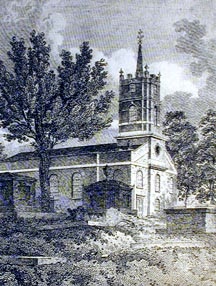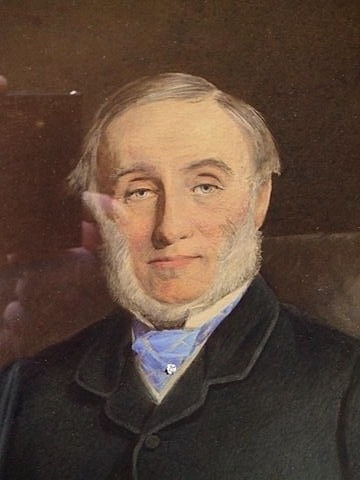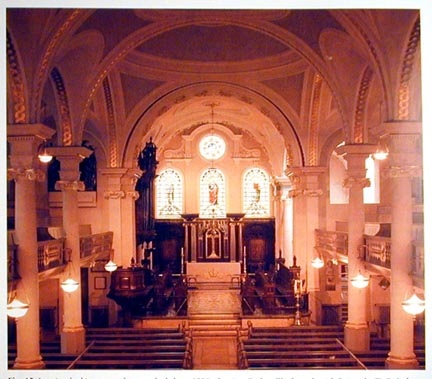THE HAMPSTEAD
PRANCES
Hampstead in the early nineteenth century was a village on the
outskirts of London set on a hill from which you could see a panorama
of the countryside and to the east the city of London with St Pauls
Cathedral. The painters Constable and Romney had a studios and lived
there for a number of years and painted several pictures of the area.
To this day it is one of the most sought after residential areas of
London.
Hampstead Parish Church 1759
ROBERT
PRANCE
1798 - 1869
William Prance the elder of Plymouth 1755-1813 married secondly Hannah
Gibbs and had two sons and two daughters by her. Her Eldest son Robert
was born 8th.April 1798 was educated in Plymton and for a while was a
clerk in his father's business. There is a wonderful letter that he
wrote to his half brother Samuel describing his journey on horseback to
london at the age of twenty four. The journey must have taken him a
fortnight and his horse had to cover over two hundred miles.
Robert became a member of the London Stock exchange in 1824. He was one
of the Members and was also one of the first to be allowed to act as
both jobber and dealer. He started a firm as R.Prance which later
became Robert Prance and Co. In 1849 Robert played a prominent role in
the exposure of George Hudson who had perpetrated fraudulent dealings
in the developing railway companies. It was a huge scandal. Hudson had
provided half of England with a network of railways and had entered
parlaiment as a Tory. He was a briliant but eccentric man who
controlled many important businesses beside the railways. He was
however flawed and Robert Prance was partly instrumental in the
disclosure of his financial shenanigans and in sorting out the affairs
of the various companies involved. For this he was amply rewarded and
no doubt his reputation greatly benefited as a result. Hudson
eventually fled to France having lost his complete fortune and later
returned to England penniless.
In 1825 Robert married Sarah Rooke of Barnstaple, N.Devon. First they
lived in Pilgrims Lane, Hampstead but later took a lease on the
property known as Frognal. Here he lived in considerable style where
the footmen wore plush breeches with white stockings and powdered hair.
He built stables for eight horses and the house came with extensive
gardens and land. He was justice of the peace and became Chairman of
the Bench at Hampstead for many years, a guardian of the poor and a
generous donor to Christ Church of which he was one of the founders and
trustees. He must have amassed a considerable fortune because in
addition he purchased several estates. There are contemporary portraits
of him which in time it is hoped to include here. His grandson recalled
an impression of a typical early victorian parent, decidely strict,
clever and ambitious, a hard working and upright man fond of horses,
horticulture and agriculture, making a benevolent squire. He was a
patron of art and helped more than one young artist. Robert died on
15th. February after a seizure the year before and was buried in the
Hampstead Parish Churchyard.
REGINALD
HEBER
PRANCE
1824 - 1912
Hampstead
Parish
Church
1990
Reginald Heber Prance was the second son of Robert above who, on his
father's death, became head of the firm of Robert Prance and Co. which
was one of the leading firms in the Consol Market, The Grand Trunk
Railway of Canada Market and the India Rupee Market. The firm dissolved
in 1885 and Reginald did little business himself after that date. He
owned the Stanley Portlarge Estate, near Winchcombe, Gloucester and
another in Kent. The Portlarge estate is still owned and farmed by
Prances. He was a much travelled man, doing India, went twice to
Tasmania and was in San Francisco during the earthquake and went over
the Andes when about 72 years of age!
At one time he was a very rich man and gave large sums to the Church.
He helped build St.Stephen's church and gave the organ. To Hampstead
Parish Church he gave a new organ, choir stalls and decorated the
chancel. At Christ Church, Hampstead he enlarged and remodelled the
organ which his father had given. He also restored the west window of
Tewksbury Abbey and gave money to a number of other churches and
monuments. Like his father Robert he was very keen on art and had a
fine collection of pictures among them Turner's Liber Studiorum which
was later sold at Christies in 1894. A number of the most important
pictures were bequeathed to the National Gallery.
Reginald died 20th.July 1912 in his 84th year and was buried, like his
father, in Hampstead Parish Churchyard.




